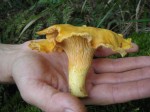 The chanterelle is common throughout the temperate zone of the northern hemisphere where it grows in troops from mid summer to fall in association with spruce and pine, sometimes with deciduous trees such as oak. They especially thrive in damp sites such as ditches and hollows, and often hide under moss or leaf litter. The mushrooms stand 2-4 ½ inches tall and the cap is 1 ¼ to 4 inches across. The egg-yellow cap is funnel-shaped, thick and fleshy at first but quickly flattens out and develops a depressed center as it matures. At the same time the inrolled margin becomes wavy and irregular. The gills like structures on the underside of the cap are widely spaced, forked near the margin, and decurrent down the stem. The cap flesh bruises orange to red and has a fruity fragrance that has been likened to apricots. The stem is smooth, thick, the same color as the cap, and tapers towards the base. The spores are cream colored.
The chanterelle is common throughout the temperate zone of the northern hemisphere where it grows in troops from mid summer to fall in association with spruce and pine, sometimes with deciduous trees such as oak. They especially thrive in damp sites such as ditches and hollows, and often hide under moss or leaf litter. The mushrooms stand 2-4 ½ inches tall and the cap is 1 ¼ to 4 inches across. The egg-yellow cap is funnel-shaped, thick and fleshy at first but quickly flattens out and develops a depressed center as it matures. At the same time the inrolled margin becomes wavy and irregular. The gills like structures on the underside of the cap are widely spaced, forked near the margin, and decurrent down the stem. The cap flesh bruises orange to red and has a fruity fragrance that has been likened to apricots. The stem is smooth, thick, the same color as the cap, and tapers towards the base. The spores are cream colored.
The Chanterelle has been considered a culinary treat since ancient times and is still highly prized in Europe for its texture, fruity fragrance, and peppery flavor. They are rarely eaten raw because cooking brings out their flavors and they are often used in wine sauces or sautéed in butter, oil, or cream. They make good additions to omelets, as well as cheese and meat dishes but may require more cooking time than other mushrooms, because of their firm, compact texture. Chanterelles can also be canned, dried, or frozen for future use.
There are other species of chanterelle that are edible but also a mushroom, Jack O’Lantern (Omphalotus olearius), that resembles chanterelles but is poisonous. Whenever collecting mushroom from the wild for consumption it is advisable to seek the opinion of an expert for identification.
Photo Credit: Andreas Rother Wikimedia Commons